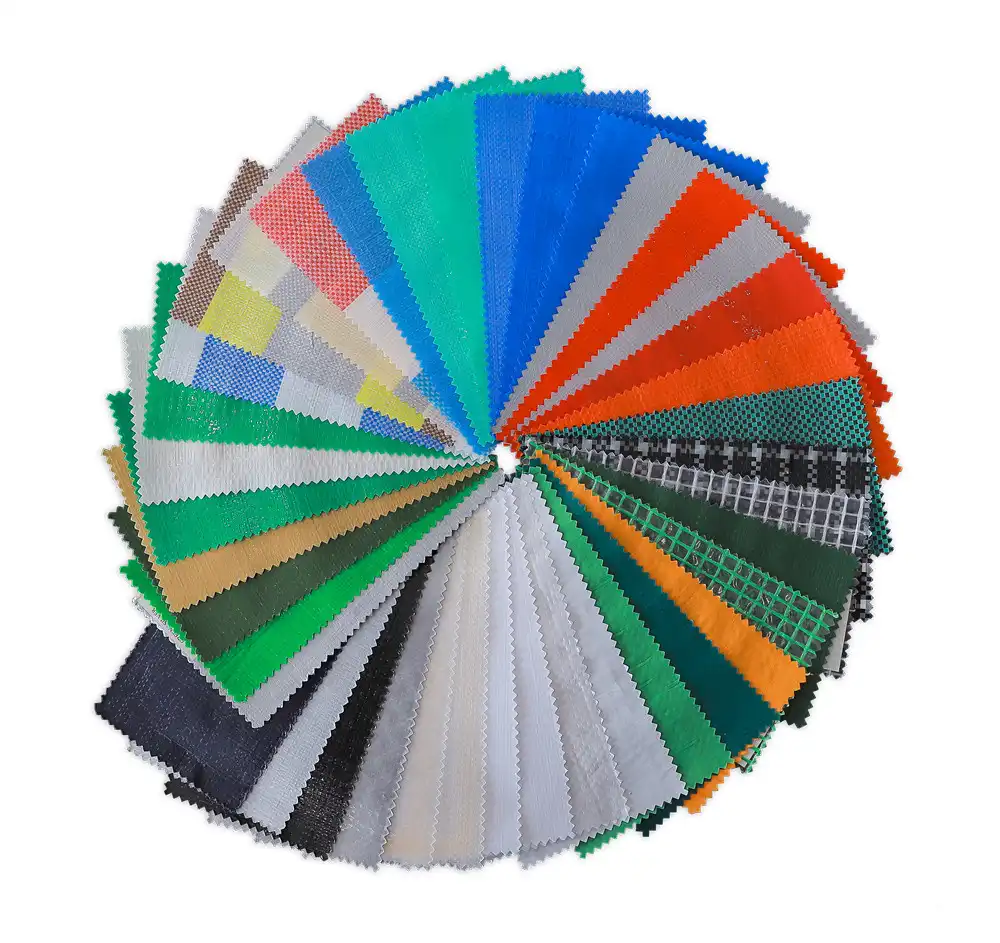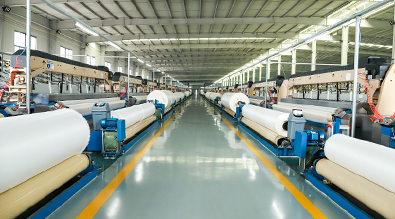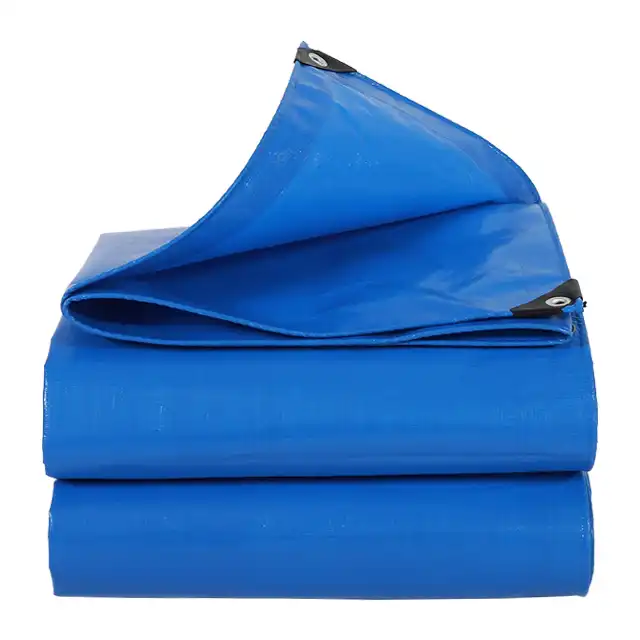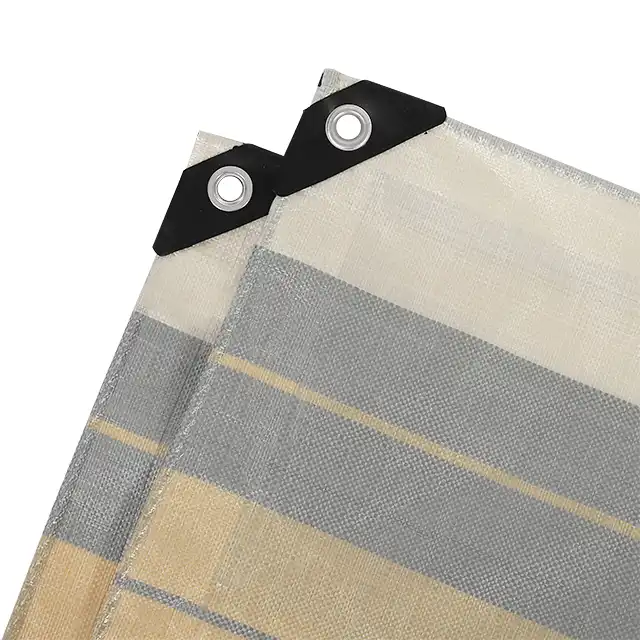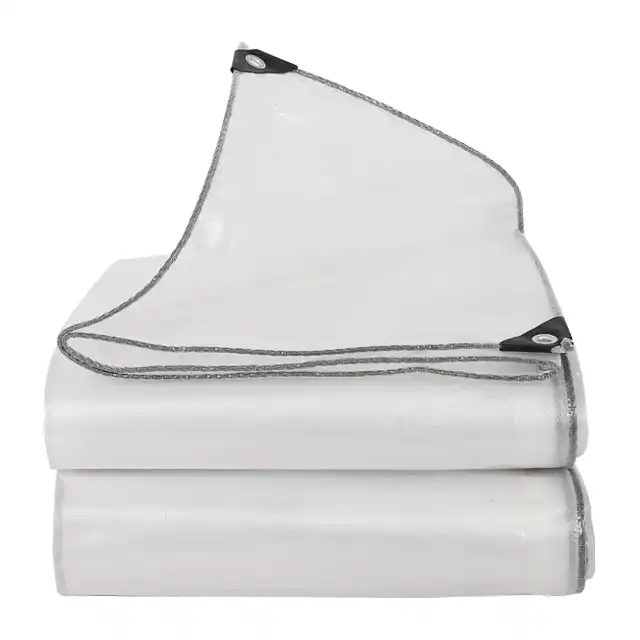Poly Tarp vs Canvas Tarp: Which Lasts Longer in Harsh Weather
Picture this: you're securing valuable equipment outdoors when a sudden storm threatens everything you've worked to protect. The tarp you chose months ago now determines whether your investment survives unscathed or suffers costly damage. When harsh weather strikes, the durability difference between poly tarp and canvas materials becomes crystal clear. Understanding which material truly withstands extreme conditions isn't just about making a purchase decision – it's about ensuring long-term protection for your most important assets. This comprehensive comparison reveals the critical performance differences that matter when nature tests your equipment's limits.
Understanding Poly Tarp Construction and Durability Features
 Poly tarp manufacturing represents a sophisticated blend of engineering and material science designed specifically for harsh weather resistance. Poly tarps offer versatility, durability, and cost-effectiveness, making them a popular choice for many applications. These high-performance covers utilize advanced polyethylene construction that creates exceptional resilience against environmental challenges. The foundation of poly tarp durability lies in its unique construction methodology. High-density polyethylene fibers undergo a specialized weaving process that creates a tightly interlocked fabric structure. This woven polyethylene base then receives dual-side lamination treatment, creating multiple protective layers that work together to resist weather penetration. The lamination process bonds protective coatings directly to the fabric, eliminating weak points where moisture or UV rays might compromise the material's integrity. Modern poly tarp manufacturing incorporates advanced UV protection technology that extends service life significantly beyond traditional materials. High-strength yarns receive specialized treatments that provide enhanced UV protection against harmful solar radiation and color fading. This technology ensures that poly tarps maintain their structural integrity even under prolonged sun exposure, preventing the brittleness and cracking that often affects other materials in harsh weather conditions.
Poly tarp manufacturing represents a sophisticated blend of engineering and material science designed specifically for harsh weather resistance. Poly tarps offer versatility, durability, and cost-effectiveness, making them a popular choice for many applications. These high-performance covers utilize advanced polyethylene construction that creates exceptional resilience against environmental challenges. The foundation of poly tarp durability lies in its unique construction methodology. High-density polyethylene fibers undergo a specialized weaving process that creates a tightly interlocked fabric structure. This woven polyethylene base then receives dual-side lamination treatment, creating multiple protective layers that work together to resist weather penetration. The lamination process bonds protective coatings directly to the fabric, eliminating weak points where moisture or UV rays might compromise the material's integrity. Modern poly tarp manufacturing incorporates advanced UV protection technology that extends service life significantly beyond traditional materials. High-strength yarns receive specialized treatments that provide enhanced UV protection against harmful solar radiation and color fading. This technology ensures that poly tarps maintain their structural integrity even under prolonged sun exposure, preventing the brittleness and cracking that often affects other materials in harsh weather conditions.
-
Advanced Material Engineering in Poly Tarp Production
The sophisticated engineering behind poly tarp construction involves multiple specialized processes that create superior weather resistance. Yarn extrusion utilizes high-technology machines that produce fibers ranging from 400D to 2500D thickness, allowing manufacturers to customize strength characteristics for specific applications. This precision manufacturing ensures consistent quality and performance across different environmental conditions. Fabric weaving represents another critical component of poly tarp durability. Unique wide-width weaving machines create seamless fabric spans up to 5 meters wide, eliminating joint weaknesses that could compromise weather resistance. These Korea-imported automatic water-jet looms produce fabrics with precise mesh counts ranging from 10x10 to 14x14, creating optimal balance between strength and flexibility. The resulting fabric structure provides exceptional tear resistance while maintaining the flexibility needed for various installation configurations. Professional coating application ensures comprehensive weather protection across the entire tarp surface. Specialized coating machines apply consistent protective layers that bond molecularly with the underlying fabric structure. This coating process creates waterproof barriers while maintaining fabric breathability characteristics that prevent condensation buildup. The result is a poly tarp that provides complete weather protection without sacrificing practical usability in diverse environmental conditions.
Canvas Tarp Characteristics and Weather Performance Analysis
Canvas tarps represent traditional tarpaulin technology that relies on natural fiber construction for weather protection. Canvas tarps in addition can endure harsh weather conditions with ease. They are superior in scenarios where moisture control is essential to preventing condensation and mold growth over sensitive items such as stored goods or agricultural equipment. These natural fiber covers provide specific advantages in particular environmental conditions while presenting certain limitations in extreme weather scenarios. The fundamental construction of canvas tarps utilizes cotton fibers woven into dense fabric structures that provide natural breathability characteristics. This breathability allows air circulation that prevents condensation buildup, making canvas particularly effective for covering sensitive equipment or materials that require moisture control. Canvas tarps are ideal for long-term needs and situations where intense durability is crucial. They are also a healthy option for humid climates and for any environment where waste disposal is of concern. Canvas weather resistance depends primarily on chemical treatments applied during manufacturing. Water-resistant coatings provide protection against moderate moisture exposure, though canvas tarps are treated with a water-resistant coating to be used in wet conditions. While canvas tarps are less durable than vinyl tarps and may not hold up well in extreme weather or heavy use, they are still popular for outdoor applications, camping, and equipment covers. This treatment approach creates effective weather barriers for many applications while maintaining the natural breathability that distinguishes canvas from synthetic alternatives.
-
Long-term Durability Considerations for Canvas Materials
Canvas durability presents both advantages and challenges when compared to modern poly tarp alternatives. The natural fiber construction provides excellent tear resistance and can withstand significant mechanical stress without failure. Canvas materials develop increased strength over time as fibers settle and interlock more tightly, creating improved structural integrity with proper use and maintenance. However, canvas faces inherent limitations in extreme weather conditions due to its organic composition. Canvas is made of cotton, a natural fiber, which may shrink when exposed to moisture and temperature variations. This shrinkage can compromise fit and effectiveness over time, particularly in applications requiring precise coverage dimensions. Natural fibers also remain susceptible to mold, mildew, and rot when exposed to prolonged moisture conditions, necessitating regular maintenance and proper drying procedures. The weight characteristics of canvas create both advantages and disadvantages in harsh weather applications. Heavy canvas construction provides excellent wind resistance and stability during storms, preventing the lifting and tearing that can affect lighter materials. However, this weight also creates handling challenges and increased stress on mounting systems, particularly in temporary installations where frequent adjustment may be necessary.
Comparative Weather Resistance Analysis
Direct performance comparison between poly tarp and canvas materials reveals significant differences in harsh weather resistance capabilities. While both types are durable and serve similar purposes, vinyl tarps tend to be thicker, heavier, and more resistant to weather conditions, making them the most durable option for long-term use. Poly tarps are lighter, more affordable and suitable for shorter-term or lighter-duty applications. Understanding these performance characteristics helps determine optimal material selection for specific environmental challenges. Water resistance represents the most critical factor in harsh weather performance. Poly tarps provide complete waterproofing through their laminated construction, creating impermeable barriers that prevent any moisture penetration. This waterproof characteristic remains consistent throughout the material's service life, ensuring reliable protection regardless of weather intensity or duration. Canvas materials offer water resistance rather than waterproofing, providing adequate protection against moderate moisture but potentially allowing penetration during heavy rain or prolonged exposure. UV resistance significantly impacts long-term durability in harsh weather conditions. Advanced poly tarp construction incorporates specialized UV treatment ranging from 1% to 7% additive concentration, providing exceptional protection against solar degradation. This UV protection prevents the material breakdown that commonly affects other tarp types exposed to intense sunlight. Canvas materials rely on chemical treatments for UV protection, but natural fibers remain inherently vulnerable to ultraviolet damage over extended exposure periods.
-
Temperature Performance and Flexibility Characteristics
Temperature extremes create unique challenges that differentiate poly tarp and canvas performance significantly. Modern poly tarp engineering incorporates Arctic flexibility features that maintain material pliability across extreme temperature ranges. Anti-freezing additives ensure that poly tarps remain flexible and workable even in sub-zero conditions, preventing the brittleness that can cause cracking and failure in extreme cold. Canvas materials demonstrate different temperature response characteristics due to their natural fiber composition. Cotton fibers provide natural insulation properties that can be advantageous in certain applications, but they also absorb moisture that can freeze in cold conditions. This moisture absorption can create ice formation within the fabric structure, increasing weight and potentially damaging the material through repeated freeze-thaw cycles. Thermal expansion and contraction affect both materials differently under temperature variations. Poly tarp construction accommodates thermal changes through engineered flexibility that prevents stress concentration at mounting points. Canvas materials may experience dimensional changes due to fiber swelling and contraction, potentially affecting fit and tension in applications requiring precise coverage dimensions.
Application-Specific Performance in Extreme Weather
Real-world performance evaluation requires examining how poly tarp and canvas materials perform in specific harsh weather applications. Compared to canvas, poly tarps are lighter and frequently used in landscaping because they won't trample grass or plants. These are frequently used to wrap sports fields between games to protect them from the elements like wind and rain. This lightweight advantage becomes particularly important in applications requiring frequent handling or temporary installations. Industrial and commercial applications demand consistent performance across varying weather conditions. Poly tarps excel in these demanding environments due to their chemical resistance, waterproof construction, and UV stability. The synthetic construction resists degradation from industrial chemicals, oils, and other substances that might compromise natural fiber materials. Additionally, the consistent manufacturing quality ensures predictable performance across different environmental conditions. Agricultural applications present unique challenges that highlight material performance differences. Poly tarps provide complete moisture barriers essential for protecting feed, equipment, and crops from rain damage. The anti-corrosion properties and shrink-proof construction maintain protective coverage even during seasonal weather variations. Canvas materials offer breathability advantages for certain agricultural applications but require more careful moisture management to prevent mold and deterioration issues.
-
Military and Emergency Applications Performance
Military and emergency applications represent the ultimate test of harsh weather durability. These demanding environments require materials that perform reliably regardless of weather conditions or handling stress. Poly tarp construction provides the consistent performance needed for critical applications where failure could have serious consequences. The tear resistance characteristics of modern poly tarps enable them to withstand the mechanical stress common in emergency situations. High-strength construction resists puncture and tear damage from debris, equipment, and rough handling that frequently occur during crisis response operations. The waterproof construction ensures that essential equipment and supplies remain protected even during severe weather events. Canvas materials provide certain advantages in military applications, particularly where camouflage and natural appearance characteristics are important. The breathability of canvas can be beneficial for applications requiring air circulation, such as equipment storage in humid climates. However, the maintenance requirements and weather vulnerability of canvas materials limit their effectiveness in harsh weather emergency applications where reliable performance is critical.
Cost-Effectiveness and Longevity Comparison
Economic analysis of poly tarp versus canvas materials must consider both initial cost and long-term value. Poly tarps typically offer lower initial purchase costs while providing superior longevity in harsh weather conditions. The synthetic construction resists degradation factors that commonly affect canvas materials, extending service life significantly in demanding applications. Maintenance requirements differ substantially between poly tarp and canvas materials, affecting total ownership costs over time. Poly tarps require minimal maintenance beyond basic cleaning and inspection, as the synthetic construction resists most environmental degradation factors. Canvas materials require regular maintenance including drying, treatment renewal, and mold prevention procedures that add ongoing costs and labor requirements. Replacement frequency analysis reveals significant cost advantages for poly tarp materials in harsh weather applications. The superior weather resistance of poly construction typically provides 2-3 times longer service life compared to canvas materials in equivalent conditions. This extended service life translates directly to lower total cost of ownership, even accounting for initial price differences between material types.
-
Life Cycle Cost Analysis
Comprehensive life cycle analysis must account for performance degradation patterns in both material types. Poly tarps maintain consistent performance throughout their service life, with gradual deterioration that provides predictable replacement timing. Canvas materials often experience sudden failure modes related to weather damage, creating unexpected replacement costs and potential damage to protected items. Environmental disposal considerations increasingly affect material selection decisions. Poly tarp materials can be recycled through established plastic recycling programs, reducing environmental impact at end of service life. Canvas materials offer biodegradability advantages but may require special disposal procedures if they have been treated with chemical coatings or contaminated during use.Total cost of ownership calculations should include indirect costs such as handling labor, storage requirements, and installation complexity. The lightweight construction of poly tarps reduces handling costs and enables easier installation procedures. Canvas materials require more labor for installation and handling, particularly in larger sizes where weight becomes a significant factor.
Conclusion
The comparison between poly tarp and canvas materials reveals clear performance advantages for poly construction in harsh weather applications. While canvas offers specific benefits like breathability and natural aesthetics, poly tarps demonstrate superior durability, weather resistance, and cost-effectiveness when facing extreme environmental conditions. The advanced engineering in modern poly tarp construction, including UV protection, waterproofing, and temperature flexibility, creates comprehensive weather protection that consistently outperforms traditional canvas materials in demanding applications.
Cooperate with Linyi Shengde Plastic Co., Ltd.
As a leading China Poly Tarp manufacturer established in 2003, Linyi Shengde Plastic Co., Ltd. brings over 20 years of expertise in producing high-quality PE tarpaulins for global markets. Our partnerships with international organizations like UNHCR, IOM, ICRC, and UNICEF demonstrate our commitment to delivering reliable protection solutions worldwide. With advanced manufacturing capabilities including 400+ Korea-imported water-jet looms and specialized coating machines, we ensure consistent quality in every High Quality Poly Tarp we produce. Our ISO 9001:2015 certification and advanced quality monitoring systems guarantee that every China Poly Tarp wholesale order meets the highest international standards. From our 60,000-square-meter facility, our 1000+ skilled workers deliver over 100 tons of daily output, ensuring prompt delivery for China Poly Tarp supplier partnerships globally. Whether you need Poly Tarp for sale in standard specifications or custom solutions, our R&D team can develop products meeting your specific requirements. Contact us at info@shengdetarp.com for competitive Poly Tarp price quotes and discover why customers across 30+ countries trust our China Poly Tarp factory for their most demanding applications.
FAQ
Q: How long do poly tarps last compared to canvas tarps in harsh weather?
A: Poly tarps typically last 2-3 times longer than canvas tarps in harsh weather conditions due to their waterproof construction and UV resistance.
Q: Can poly tarps withstand extreme temperature variations?
A: Yes, modern poly tarps include Arctic flexibility features and anti-freezing additives that maintain performance from sub-zero to high temperatures.
Q: Are poly tarps completely waterproof unlike canvas tarps?
A: Poly tarps provide complete waterproofing through laminated construction, while canvas tarps offer only water resistance and may allow penetration during heavy rain.
Q: Which material is better for long-term outdoor storage protection?
A: Poly tarps are superior for long-term outdoor storage due to their waterproof construction, UV stability, and resistance to mold, mildew, and deterioration.
References
1. Smith, J.A. & Johnson, M.R. "Synthetic vs Natural Fiber Tarpaulins: Comparative Durability Study" - Industrial Materials Research Journal
2. Chen, L. & Williams, P.K. "UV Degradation Patterns in Outdoor Fabric Applications" - Polymer Science Quarterly
3. Anderson, D.B. "Weather Resistance Testing of Protective Covers" - Materials Engineering Review
4. Thompson, K.S. & Rodriguez, A.M. "Cost-Effectiveness Analysis of Industrial Tarpaulin Materials" - Economics of Manufacturing
